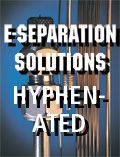Technology Forum: Hyphenated Techniques
Joining us for this discussion are Diab Elmashni and Eric Phillips of Thermo Fisher Scientific; Michael McGinley of Phenomenex; and Doug Later of Torion.
The popularity of various chromatographic techniques and technologies may ebb and flow, but at least one thing has been constant in the field of separation science over the course of the last decade-plus: the continued growth of hyphenated techniques and the instrumentation those techniques require.
Joining us for this discussion of hyphenated techniques are Diab Elmashni and Eric Phillips of Thermo Fisher Scientific; Michael McGinley of Phenomenex; and Doug Later of Torion.
With Pittcon approaching, do you expect to see any major developments in the LC-MS and GC-MS fields?
Elmashni: There will be a strong drive toward customer and application dedicated solutions.
Phillips: While I expect to see few new developments at Pittcon for GC or GC-MS, I do expect updates to products, updates in technology, and a focus on software. There will be a continuation of providing a solution to the customer and not just the instrumentation.
McGinley: We foresee additional innovations in the fast HPLC field as people look for additional solutions for performing their separations more efficiently in less time, which is especially important for LC–MS analysis in the current economic times; researchers are trying to get more samples run with existing capital hardware. In addition, with the worldwide shortage in acetonitrile, we see researchers looking for solutions that use less acetonitrile or use alternate organic mobile phases (methanol or isopropanol for example). For those that must use acetonitrile for their separations, we see a movement from the standard 250 x 4.6 mm analytical dimension to using shorter columns with smaller internal diameters.
Later: It is always interesting to walk the floor at Pittcon in search of the next major development(s) in LC–MS and GC–MS. Typically, one finds many incremental developments that continue to move newer technological developments along in terms of providing better solutions to challenging and routine applications. While I really don't anticipate finding any specific "major" development at Pittcon this year, I would not be surprised either because the LC–MS and GC–MS industry can regularly be relied upon for interesting and meaningful developments ranging from new columns to innovative MS instrumentation.
Compare the strengths and weaknesses of LC–MS and GC–MS in relation toeach other.
Elmashni: LC–MS and GC–MS are complementary technologies and having both technologies enables a user to be able to conduct a wider range of analyses. UHPLC-MS can save a tremendous amount of sample preparation and clean-up time for some samples compared to GC–MS. A good example is drugs of abuse in food matrices.
Phillips: These two analytical techniques are complementary. There is no reason to compare strengths and weaknesses. There are classes of compounds that can be analyzed with greater ease and faster on GC–MS, for example chlorinated pesticides. There are also classes of compounds that are much better suited to LC–MS, for example carbamates.
McGinley: LC–MS has an advantage in its universality for analyzing most compounds. A large majority of analytes can be run using a reversed-phase LC–MS system without a need for derivatization, which is often necessary for polar compounds to be analyzed by GC–MS. GC–MS provides a big advantage for compounds that can be analyzed by GC in that it provides much greater chromatographic resolution between compounds than LC columns traditional can. For mass resolution and accuracy, high-end LC–MS instruments can provide much better performance than GC–MS instrumentation, but GC–MS instruments tend to be less expensive than LC–MS instrumentation. For sensitivity and speed, it is a toss-up between technologies with the advent of fast LC, often this is dependant on the application being run.
Later: In general, the strength of LC–MS is its applicability to analyzing non-volatile, high molecular weight, and polar molecules, while GC–MS is the approach of choice for high-resolution analysis of more volatile, less polar, lower molecular weight compounds. However, the use of derivatization techniques can also expand the application reach of GC–MS, for example, melamine detection in milk by GC–MS, which has recently garnered global attention. I prefer to look at each technology in terms of understanding their capabilities rather than assessing their strengths and weaknesses. Each technology can be broadly applied to create solutions to specific applications if approached with understanding of their capabilities.
GC–MS has recently been a key player in the homeland security industry. What industries do you see GC–MS and LC–MS making an impact on in the future?
Elmashni: The food safety industry is a strong and upcoming industry with regards to contaminants in food products.
Phillips: Various types of environmental analyses will begin to take the forefront of analytical chromatographic testing. There is also a lot of pressure for cleaner air, water, and soil. These two techniques are able to detect and quantitate large numbers and many different types of organic contaminants.
McGinley: Food and beverage testing as well environmental testing are areas where GC–MS was dominant in the past. That is now changing as many are adopting LC–MS methods that sometimes can deliver better sensitivity that GC–MS methods. Both technologies (LC–MS and GC–MS) are seeing growth in the neutraceutical/food supplement market as government regulation is enforcing improved quality control methodology on that industry. With the growing concern about global food safety, we are already seeing a dramatic growth in analytical testing of food products (melamine testing for example) by both LC–MS and GC–MS methods and that trend should continue in the near future.
Later: Taking the instrument to the sample source, whether that is an airport security station, a battle field, a shipping dock, or a processing plant floor has become a motivating and challenging priority over the recent past. In order to do this, at least three objectives must be accomplished. First, MS-based instrumentation must be miniaturized so that it is portable and robust enough to take into the field for on-site measurements. Second, technology development must support near real-time analysis on the order of 1-3 minutes for production of time-effective date. Third, the instrumentation must be automated and easy to operate for nontechnical personnel, including auto-identification of target analytes. At this point in time, GC–MS has the developmental edge, primarily due to miniaturization for transportability and speed of analysis. As these objectives are met, MS instrumentation will play a vital and increasing role in not only homeland security and threat detection, but also in a broad spectrum of other fields like product quality verification, food safety, environmental monitoring, assessment, pollution mapping, forensic detection, etc.
What was the biggest accomplishment or news in 2008 for GC–MS and LC–MS?
Elmashni: The GC–MS triple quadrupole has enabled advanced sensitivity by taking reliable GC technology and coupling it to the world’s best MS systems with the Thermo Scientific triple quadrupole.
Phillips: In line with Diab’s comments, the advances seen in technology, especially applied to triple quadrupoles, have provided significant improvement in detectability of contamination in heavy matrix.
McGinley: One notable piece of news for 2008 that was relevant to both the GC–MS and LC–MS markets was highlighted at the Beijing Olympics. Several notable athletes tested positive for performance enhancing drugs as well as many others withdrew from participating in the Olympics to avoid drug testing. This really highlights the success of drug testing programs that use advanced analytical technologies like LC–MS and GC–MS. Doping athletes now realize that they cannot beat the system and this new culture of "fairness" would not have been possible without advances in GC–MS and LC–MS instruments. Most LC–MS and GC–MS drug testing methods are highly sensitive and rugged such that they cannot be "fooled" by the various masking techniques that doping athletes performed in the past.
Later: Admittedly it is difficult to judge this type of accomplishment in a short fixed time window without longer-term observation to determine viability, sustainability, and true impact. I prefer to view accomplishments in terms of direction. For example, developments in the area of solid phase microextraction are impacting the speed and ease of sample collection and preparation for both LC–MS and GC–MS. Another example is the attention being given to data processing software, which is making steady progress toward better automation in terms of quantitative and qualitative analysis. Mass-based compound deconvolution is moving both LC–MS and GC–MS towards major impacts in rapid data processing and interpretation for target and unknown compound analysis. Another more recent innovation is the use of orthogonally integrated quadrupolar and magnetic fields in GC–and LC–MS instrumentation to enhance ionization efficiency, ion transfer efficiency between source and analyzer regions, and electron capture dissociation operations in multi-dimensional MS–MS instrumentation. This more recent technology is leading to a better understanding of molecular structure in biomolecules using LC-ECD-MSn and an order of magnitude increased sensitivity in GC–MS measurements for environmental pollutants, just to mention two examples.
Characterizing Plant Polysaccharides Using Size-Exclusion Chromatography
April 4th 2025With green chemistry becoming more standardized, Leena Pitkänen of Aalto University analyzed how useful size-exclusion chromatography (SEC) and asymmetric flow field-flow fractionation (AF4) could be in characterizing plant polysaccharides.
Investigating the Protective Effects of Frankincense Oil on Wound Healing with GC–MS
April 2nd 2025Frankincense essential oil is known for its anti-inflammatory, antioxidant, and therapeutic properties. A recent study investigated the protective effects of the oil in an excision wound model in rats, focusing on oxidative stress reduction, inflammatory cytokine modulation, and caspase-3 regulation; chemical composition of the oil was analyzed using gas chromatography–mass spectrometry (GC–MS).






